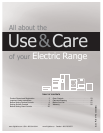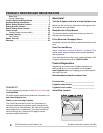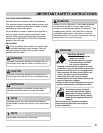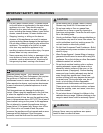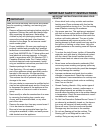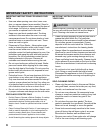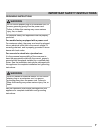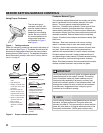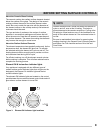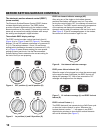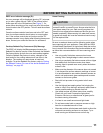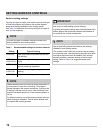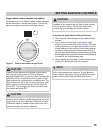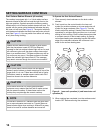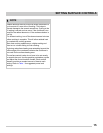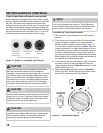
6
IMPORTANT SAFETY INSTRUCTIONS
IMPORTANT INSTRUCTIONS FOR USING YOUR
OVEN
• Use care when opening oven door, lower oven
door, or warmer drawer (some models). Stand to
the side of the appliance when opening the door of
a hot range. Let hot air or steam escape before
you remove or replace food in the oven.
• Keep oven vent ducts unobstructed. Touching
surfaces in this area when the oven is on may
cause severe burns. Do not place plastic or heat-
sensitive items on or near the oven vent. These
items can melt or ignite.
• Placement of Oven Racks - Always place oven
racks in desired location while oven is cool. If rack
must be moved while oven in hot, do not let
potholder contact hot heating element in oven. Use
potholders and grasp the rack with both hands to
reposition. Do not let potholders contact the hot
heating elements in the oven. Remove all
cookware and utensils before moving the rack.
• Do not use a broiler pan without its insert. Broiler
pans and inserts allow dripping fat to drain away
from the high heat of the broiler. Do not cover the
broiler insert with aluminum foil; exposed fat and
grease could ignite.
• Protective Liners—Do not use aluminum foil to line
oven bottom or any other part of the appliance.
Only use aluminum as recommended for baking if
used as a cover placed on the food. Any other use
of protective liners or aluminum foil may result in a
risk of electric shock or fire or a short circuit.
• Do not cook food on the oven bottom. Always cook
in proper cookware and always use the over racks.
FOR GLASS COOKTOP ONLY
• Do Not Clean or Operate a Broken Cooktop. If cooktop
should break, cleaning solutions and spillovers may
penetrate the broken cooktop and create a risk of
electric shock. Contact a qualified technician immedi
-
ately.
• Clean Cooktop Glass with Caution. If a wet sponge or
cloth is used to wipe spills on a hot cooking area, be
careful to avoid a steam burn. Some cleaners can
produce harmful fumes if applied to a hot surface.
• Avoid Scratching the cooktop glass with sharp objects.
IMPORTANT INSTRUCTIONS FOR CLEANING
YOUR OVEN
• Clean the range regularly to keep all parts free of
grease that could catch fire. Pay particular
attention to the area around each surface element.
Do not allow grease to accumulate. Greasy
deposits in the fan could catch fire. Follow the
manufacturer’s instructions for cleaning hoods.
• Always follow the manufacturer’s recommended
directions for use of kitchen cleaners and aerosols.
Be aware that excess residue from cleaners and
aerosols may ignite causing damage and injury.
• Clean ventilating hoods frequently. Grease should
not be allowed to accumulate on the hood or filter.
Follow the manufacturer’s instructions for cleaning
hoods.
• Do not touch a hot oven light bulb with a damp
cloth. Doing so could cause the bulb to break.
Disconnect the appliance or shut off the power to
the appliance before removing and replacing the
bulb.
SELF-CLEANING OVENS
• Clean only the parts listed in this manual. Before
using self-clean, remove the broiler pan, any food,
utensils, and cookware from the oven.
• Do not use oven cleaners. No commercial oven
cleaner or oven liner protective coating of any kind
should be used in or around any part of the
appliance.
• Do not clean the oven door gasket. The door
gasket is essential for a good seal. Care should be
taken not to rub, damage, or move the gasket.
• Some birds are extremely sensitive to the fumes
given off during the self-clean cycle of any oven.
Move birds to another well-ventilated room.
• Remove oven racks. Oven racks color will change
if left in the oven during a self-cleaning cycle.
Before manually cleaning any part of the appliance,
be sure all controls are turned off and the range is
cool. Cleaning a hot oven can cause burns.
CAUTION



